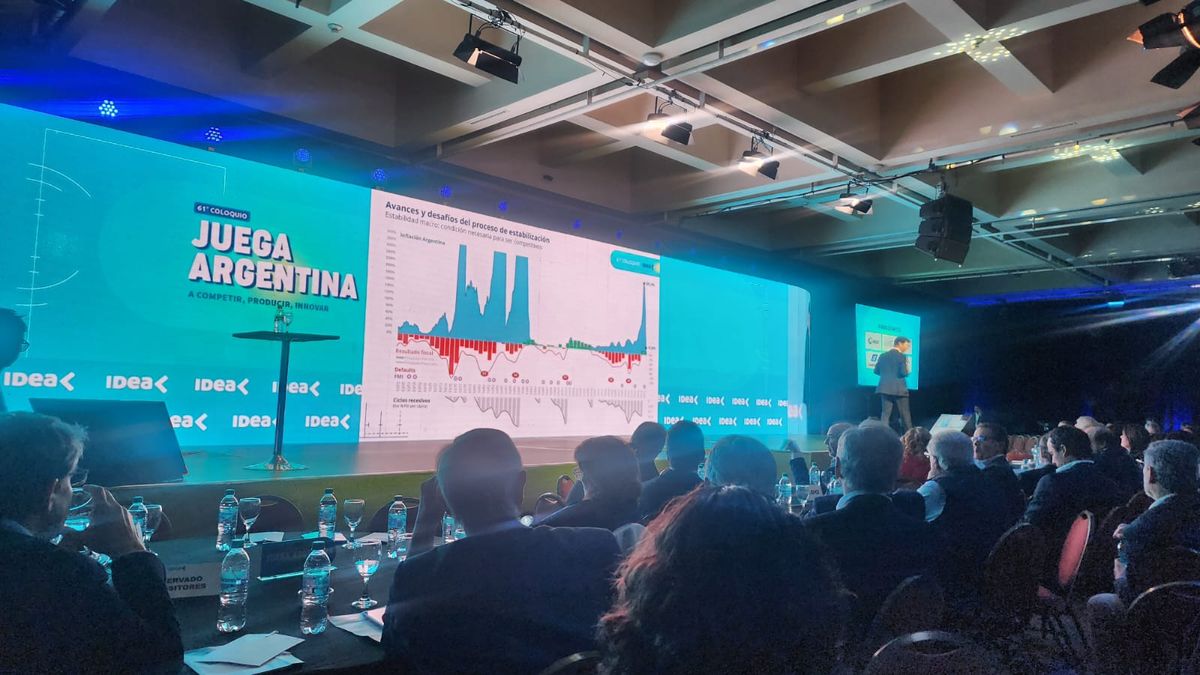At the decision-making tables of the main economic agents, the gaze today seems focused on elucidating the next steps of official economic policy. The summer, presented by officials as a transition, is approaching its end and expectations are, once again, on the dollar. Among other aspects, in the plans for the stocks. As Ámbito said, although there are still no specific dates, the Government has already identified the restrictions on the operation of financial exchange rates that it will aim to remove. In the market, the predominant view is that this disarmament will be done gradually.
Although Javier Milei assures that we are getting closer to the objective and that the International Monetary Fund (IMF) places it near the middle of the year, the exit from the stocks still does not have a defined schedule. In the Government, the idea prevails that at least the number of net reserves should have been balanced (which today are negative by around US$4.4 billion, according to calculations by the Cohen firm). “An IMF forecast is that it could be finished by the middle of the year, but what President Milei has said is that, if things go well as they have been until now, maybe it will be finished even sooner,” said José Luis Espert on Tuesday. , president of the Budget and Finance Commission of the Chamber of Deputies, after sharing a panel with Milei at Expoagro.
As he knew Ambit From sources with knowledge of the subject, officials are fine-tuning the package of restrictions to be dismantled in both the official and capital markets, but the mechanics with which this removal will be implemented has not yet been resolved.
Luis Caputo in TN.jpg
Puts or repurchase options played a key role in underpinning Luis Caputo’s bids.
Financial movements seem to align with the idea of a gradual exit. In addition to what the actions of the economic team suggest, Analysts observe that the market prices this scenario. The consulting firm 1816 analyzed it in light of the prices of sovereign debt in pesos indexed to inflation, which continued to operate upwards during the last week.
“The most notable thing is that the forward rates in the CER curve As of Q4 2024 they are already well into single-digit territory. If we take the T4X4 as a reference and calculate the forwards of the CER bonds maturing in 2025 onwards, we see that the market has priced in that on October 14 no Boncer would yield more than CER plus 6.2%, which implies parities towards the end of the year above 90%, very far from those of hard dollar bonds even after the recent rally,” he analyzed 1816.
What does that imply from your point of view? that that firmness of the debt market in pesos shows that it already “practically does not estimate the possibility of any stress on the sovereign curves in local currency after a potential exchange rate unification (a necessary precondition if the Government decides to advance a ‘free currency competition’ scheme).” In other words, that is discounted a soft landing of what remains of the “overhang (surplus) of pesos with “a gradual dismantling of the still numerous restrictions on financial FX”.
Analysts do not see a quick exit from the stocks
Damian Pierri, economist and researcher (UBA-Conicet and Autonomous University of Madrid), agrees that super negative rates “do not price” an immediate exit from the stocks en bloc. He considers that the logical thing, based on the attempt to clean up the Central Bank’s balance sheet, would be to do so to recover the ability to carry out monetary policy and set positive returns when exchange control is dismantled. When that happens, it will impact the price of indexed securities. “I don’t see a quick exit from the stocks and the CER curve is a sign in that sense,” holds.
Although there is another factor that drives the demand and prices of these bonds. Both Pierri and 1816 believe that, in part, it is due to the impact of the BCRA liquidity insurance offer for banks in carry trade strategies. These puts or repurchase options played a key role in supporting the tenders of Luis Caputo and his Secretary of Finance, Pablo Quirno, by encouraging financial entities to dismantle Central Bank passes and migrate to Treasury debt, with the guarantee that whenever they want If you get rid of the securities, the monetary authority will come out to buy them back. A risky strategy that made the stock of this “latent debt” of the BCRA grow to more than $14 billion. “There are two factors, it is difficult to know which one weighs more,” says Pierri.
The consulting firm, beyond the role of these insurances, points out that “it also reflects the growing confidence of a market that ‘chooses to believe'” in the Government’s plan, despite reasonable doubts about the sustainability of the shock adjustment plan via liquefaction (which plummeted the income of retirees and workers and worsened the recessionary scenario) that is reflected in the difficulties of placing debt without resorting to puts.
Javier Casabalfrom Adcap Grupo Financiero, highlights that “exchange rate unification, lifting restrictions, can only be done having first recovered the demand for money” and considers that it is going in that direction. “But there is still a way to go, fiscally and financially. For now, the Treasury should begin to make tenders without puts that begin to show greater confidence in this administration. Otherwise, the pesos that were rolled until 2026 or 2027, if they get ‘scared’, can become very short-term debt if the puts are executed, re-editing the Leliq risk,” he warns.
“Due to the price of the assets, the market is pricing a dismantling of the stocks for before the end of this year that would not be traumatic for the peso bond market. And that implies that the removal of exchange restrictions is gradual. Always, since the campaign, The proposal was fiscal shock and exchange rate gradualism, which is what is happening. “I do not see a scenario where all block restrictions are removed and banks can freely buy dollars against the sale of their bond holdings in pesos (through the execution of puts),” he analyzes. Nicolas RivasBAVSA operator.
Beyond the restrictions on the MEP dollar and the CCL, it also puts on the table the policy applied in the official market. “On the one hand, they are organizing the debt stock of importers with the issuance of the BOPREAL and the amount of issuance of these bonds is very similar to what the BCRA was purchasing in the exchange market, where they are also kicking payments forward. of imports,” he points out. Thus, he considers that given the need to obtain liquid dollars to get out of negative net reserves, the conditions are not in place to remove the short-term staggered payment of imports, which was what allowed us to open a four-month window to buy foreign currency during the summer. A window that will close in April, when the monthly volume of purchases abroad will be balanced with scheduled payments.
CEPO _DOLAR_CAPUTO.png

The Government already has a list of restrictions on the operation of financial dollars that it plans to remove.
Ambit
Financial dollar: the restrictions they plan to remove
Beyond the way in which it is implemented, as this medium advanced, The Government already has a list of restrictions on the operation of financial dollars that it plans to remove.. Firstly, it is planned to eliminate the daily limit of $200 million to operate or transfer securities used in the purchase and sale of financial dollars, as well as the obligation to report operations five days in advance.
The one-day parking (minimum holding period for the securities with which MEP and CCL are purchased) will drop to zero. In addition, it is planned to remove the rule of the National Securities Commission (CNV) that prevents the purchase of financial dollars in the event of having taken collateral.
Outside the universe of CNV regulations, the elimination of BCRA Communication A 7340 is also being studied. The rule establishes that every time a security is sold against dollars, those currencies must be transferred to a bank account before they can be used again to operate.
The same occurs with a set of regulations for mutual investment funds (FCI). One of them is the prohibition of offering bimonetary funds, that is, made up of both dollars and pesos. The same happens with the impediment to subscribing FCI in kind, particularly with negotiable securities denominated in dollars, a mechanism that was interrupted last year since it was used as a way to avoid exchange restrictions.
Source: Ambito
I am a 24-year-old writer and journalist who has been working in the news industry for the past two years. I write primarily about market news, so if you’re looking for insights into what’s going on in the stock market or economic indicators, you’ve come to the right place. I also dabble in writing articles on lifestyle trends and pop culture news.




